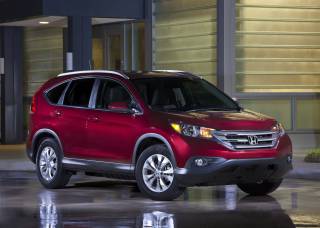
The current Honda CR-V is one of the best-selling vehicles in the country, let alone in the the small crossover segment, and the redesigned 2012 version doesn’t stray far from the formula that has made it so popular: It’s easy to drive, has lots of room for its size and gets good mileage.
Improvements to the 2012 Honda CR-V’s interior, cargo configurability, ride quality and standard-equipment list should keep the compact crossover atop car shoppers’ must-test lists.
What’s New
The CR-V drives more like a car now and has a new interior, but the exterior design stands out as being much more interesting than the current model. The front has a forward slope to it, with a large grille that actually cuts into the headlights. This is bold stuff, but without being ugly-bold like the Honda Crosstour. It won’t offend.
The back end is even more of a departure, taking the vertical taillight theme from the previous generation even further. It reminds me of Volvo’s sleek XC60 crossover.
From the side I thought the CR-V was longer than before, but my eyes were playing tricks on me. The CR-V is almost an inch shorter than the model it replaces, while the wheelbase stays the same. The CR-V isn’t as tall, though, and that’s definitely noticeable as you look over the roof.
Interior
Compared with the rest of the class — and certainly with the outgoing CR-V — the 2012 is modern and sophisticated. While it isn’t a significant step up from the Chevy Equinox or Hyundai Tucson, it shares head-of-the-class status with those two in terms of quality.
Where it shines above the rest is in the comfort level for all passengers in a small space.
While the Equinox is comfortable, it’s a much larger vehicle: 187.8 inches in length versus the CR-V’s 178.3 inches. That’s a considerable difference. However, despite this difference in exterior size the CR-V has more passenger volume. The Equinox has roughly 100 cubic feet, while the CR-V is rated at 101.5 cubic feet for the EX and higher trims and 104.1 cubic feet for the LX model.
The Tucson is smaller inside and out, and you’ll feel it in the cramped interior and firm seats.
Inside the new CR-V, there’s 0.4 inches more driver’s seat height adjustment and 0.8 inches more travel for the tilt/telescoping steering wheel than there was in the previous version.
The front seats are very comfortable. One of the recently redesigned Civic’s positives is its comfort as a daily driver, and the CR-V is similarly cozy. The vehicle I tested was a loaded EX-L with leather seats, which won raves from my co-pilot as well. There’s plenty of thigh support, and if the Civic’s cloth seats are any indication, the CR-V’s should be more than acceptable.
Another major change for the better is a center console that runs from the armrest all the way to the dashboard. The outgoing CR-V wasted the space between the console and dash with an open floor. This new console has a large storage compartment (it could fit a small shopping bag from Starbucks and then some) and two cupholders below the shifter. There are also small storage bins on the side of the console — near where a driver’s knee would be — below the cupholders that can hold a spare water bottle or other items you want to stash away.
There’s plenty of room for adults in the backseat. Sitting directly behind the driver’s seat that was in position for my 5-foot-10 frame, I had a few inches of knee room. I also installed a large, convertible child-safety seat in the backseat. It fit well, with enough space for a child like my 2-year-old to just miss kicking the front seat.
Performance
Under the hood remains the same 2.4-liter four-cylinder engine and five-speed automatic as the 2011 CR-V. Through various adjustments to the engine tuning, the 2012 CR-V gains five extra horsepower, putting it at 185 horses and 163 pounds-feet of torque. Yet better aerodynamics increase the mileage substantially, to 23/31 mpg city/highway (up from 21/28 mpg). By comparison, the Hyundai Tucson is rated at 23/31 mpg and Chevy’s Equinox at 22/32 mpg.
For the 2012 CR-V, Honda is debuting an all-new all-wheel-drive system. It delivers up to 100 percent of the power to the front or rear wheels to offer better grip at low, takeoff speeds, when it senses slippage due to road conditions.
The new, lightweight electronically controlled system leads to a big mileage gain for all-wheel-drive CR-Vs, putting it at 22/30 mpg, which tops the class. The comparable Equinox is rated 20/29 mpg, the Tucson gets 21/28 mpg and the Subaru Forester is rated 21/27 mpg with standard all-wheel drive.
I tested an all-wheel-drive model through hilly California roads in various states of smoothness, disrepair and open construction. The new model handles these road conditions smoothly, without the undulations of the previous generation.
The electric power steering is exceptionally light, requiring little effort to turn the car. It’s responsive enough on twisty roads, but just barely. It is definitely not tuned for at-the-limits driving.
It’s also very quiet inside the cabin, even over concrete freeways. The CR-V launches from a stop smoothly, has plenty of power for passing on highways and is generally very smooth when shifting between gears. It does generate some buzz under moderate acceleration up steep hills. I was able to test it against the current Toyota RAV4 and the previous-generation CR-V, and in this specific driving condition the buzzing was actually worse in the 2012 CR-V than in those two, though it’s otherwise quieter in most circumstances.
The RAV4’s ample power and responsiveness were surprising when tested back-to-back with the CR-V, but for most crossover drivers I don’t think they’re distinguishing enough traits to put it ahead of the CR-V.
There’s also an Econ button on all CR-Vs that alters feedback and driving characteristics to elicit more fuel-efficient driving behaviors, but doesn’t adjust the engine or transmission to actively save fuel. The result is drivers will have to push down on the accelerator pedal more to get the same amount of acceleration. The climate control is also adjusted incrementally, but otherwise the feature doesn’t impact many of the car’s driving characteristics.
Cargo
Cargo room behind the backseat has increased 1.5 cubic feet to 37.2 cubic feet. Maximum cargo capacity with both rear seats folded, however, is down 2 cubic feet to 70.9. But the numbers don’t tell the full story.
The rear seats now fold flat into the floor versus the previous generation’s, which folded down and then tumbled forward against the front seats. To fold the seats flat now you simply pull a lever on either side of the cargo area. That automatically springs the seat bottoms and backrests forward and down to create a low, flat floor. You can also lower the seats via controls on the seats themselves if you’re at a side door rather than behind the cargo area. This ease of use is such a great improvement it can’t be overlooked, and the area is plenty large for this vehicle category.
The RAV4 is rated at 36.4 cubic feet with the second row in place and 73 cubic feet with it down. The Subaru Forester, at 33.5 and 68.3 cubic feet, and the Chevy Equinox, at 31.5 and 63.7 cubic feet, respectively, are both smaller.
Features, Trims & Technology
Pricing for the new CR-V hadn’t been announced at the time of publication, but Honda says it will range between $21,000 and $30,000. However, we do have complete trim level information and expect pricing among the trims to be similar to the current generation’s pricing.
Trims include the base LX, EX, EX-L, EX-L Navi and EX-L RES. Honda categorizes equipment packages like navigation and rear-entertainment systems (that’s the EX-L RES version) as separate trim levels, which cuts down on shoppers having to pick confusing option packages.
The LX is well-equipped with high-tech new standard features, including a 5-inch information screen, a backup camera, Bluetooth, a USB input, Pandora internet-radio capability, cruise control, 16-inch steel wheels and power windows.
There’s also standard text messaging functions. The system can read incoming messages aloud and send pre-determined messages out, like “I’m running late,” as long as you have a compatible smartphone. Most new BlackBerry phones and a few Android phones are compatible with the system, but the iPhone isn’t.
The EX adds a six-speaker stereo, a moonroof, 17-inch alloy wheels, a one-touch up/down driver’s window, power door locks, body-colored door handles and side mirrors, and a security system.
The EX-L adds leather seating, a 10-way power driver’s seat, dual-zone climate control, a seven-speaker stereo with satellite radio, and heated side mirrors.
The EX-L Navi features a navigation system with a 6.5-inch screen, voice recognition and live traffic information.
The EX-L Res doesn’t come with the navigation system but adds a 7-inch screen to the ceiling for the backseat. It’s a relatively small screen, and the DVD system eats into the center console’s generous cargo space. As a parent who is constantly taking an iPad along on road trips, I find built-in systems like this less useful and less flexible than an affordable portable alternative.
Safety
The 2012 Honda CR-V has not yet been tested by the National Highway Traffic Safety Administration or the Insurance Institute for Highway Safety.
The CR-V comes with standard front seat-mounted side airbags and side curtain airbags for both rows of seats. Antilock brakes and an electronic stability system are also standard, as is required of all 2012 models.
CR-V in the Market
The current CR-V is one of the best-selling vehicles in the country. The 2012 is an improvement in every way, and if the company can keep prices from escalating, it’s sure to continue its successful run.































